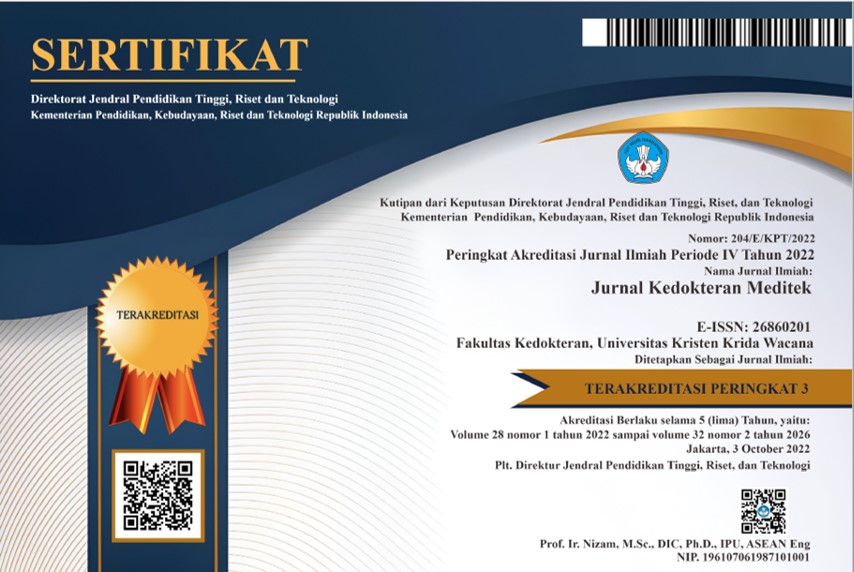Peranan Enzim Glukosa 6 Fosfat Dehidrogenase dalam Mempertahankan Integritas Membran Sel Darah Merah terhadap Beban Oksidatif
DOI:
https://doi.org/10.36452/jkdoktmeditek.v21i56.1257Abstract
Abstrak
Enzim glukosa 6 fosfat dehidrogenase (G6PD) merupakan enzim yang diperlukan dalam proses oksidasi molekul glukosa melalui jalur pentosa fosfat (Hexoxe mono phosfat shunt / HMP shunt). Pada proses tersebut dihasilkan molekul Nicotinamide Adenine Dinucleotide Phosphate tereduksi (NADPH). Salah satu peranan penting NADPH adalah untuk mereduksi glutation teroksidasi, glutation–sulfur–sulfur-glutation (GSSG), membentuk glutation tereduksi, glutation-sulfhidril (GSH) yang dikatalisis oleh enzim glutation reduktase. Defisiensi enzim G6PD dapat mengakibatkan terakumulasinya senyawa toksik hidrogen peroksida (H2O2), merupakan salah satu senyawa oksigen reaktif. Defisiensi enzim G6PD merupakan kelainan genetik herediter, terkait kromosom seks (X-linked). Beberapa penelitian tentang defisiensi enzim G6PD di Indonesia telah dilaporkan, salah satu di antaranya adalah tentang prevalensi kejadian defisiensi G6PD pada 1.802 bayi baru lahir di rumah sakit Ibu dan Anak (RS Bunda). Dari hasil pemeriksaan diketahui 94 bayi baru lahir mengalami defisiensi G6PD. Persentase kejadian G6PD pada bayi laki-laki (6.26%) lebih besar dari pada bayi perempuan (4.07%). Membran biologis tersusun dari suatu dwilapis lipid, protein, dan sejumlah kecil karbohidrat. Apabila lipid membran sel darah merah terpajan/teroksidasi oleh senyawa oksigen reaktif, maka dapat membentuk suatu peroksida lipid, disebut dengan proses peroksidasi lipid. Proses ini bersifat autooksidasi dan tidak saja melisiskan membran sel darah merah, juga dapat menyebabkan kerusakan jaringan.
Â
Kata Kunci : Glukosa 6 fosfat dehidrogenase, senyawa oksigen reaktif
Â
Abstract
Glucose 6 phosphate dehydrogenase (G6PD) is an enzyme that is necessary in the process of oxidation of glucose molecules through the pentose phosphate pathway (Hexoxe mono phosphate shunt / HMP shunt). In the process generated reduced Nicotinamide adenine dinucleotide phosphate (NADPH) molecule. One of the important role of NADPH is to reduce oxidized glutathione, glutathione–sulfur–sulfur–glutathione (GSSG), to form reduced glutathione, glutation sulfhydril (GSH), which is catalyzed by the enzyme glutathione reductase. G6PD enzyme deficiency can lead to the accumulation of toxic compounds of hydrogen peroxide (H2O2), is one of the reactive oxygen compounds. G6PD enzyme deficiency is an inherited genetic disorder, related to the sex chromosome (X-linked). Several studies of G6PD enzyme deficiency in Indonesia has reported, one of them is about the prevalence of G6PD deficiency in 1.802 newborns in the hospital Mother and Child (Bunda Hospital). From the results of the examination found 94 newborns with G6PD deficiency. The percentage incidence of G6PD in male infants (6,26%) is greater than in female infants (4,07%). Biological membranes are composed of lipid bilayer, protein and a small amount of carbohydrates. If the red blood cell membrane lipids exposed / oxidized by reactive oxygen compounds that can form a lipid peroxide, called lipid peroxidation process. This process can cause autooxidation and not just damage red blood cell membrane, and even can cause tissue damage.
Â
Key Words : Glucose 6 phosphate dehydrogenase, the reactive oxygen compounds
















